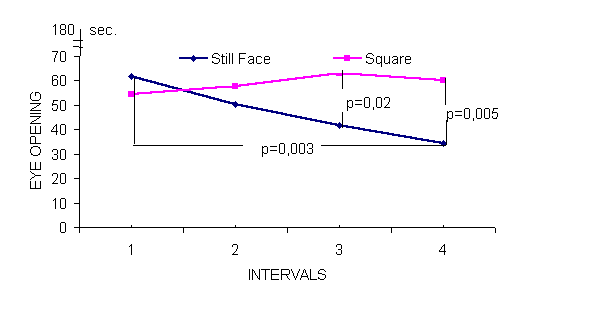Visual behavior towards a still face at birth
V. Langher, M. Cecchini, C. Lai, B. Margozzi and T. Taeschner
Department of Developmental and Social Psychology, University of Rome "La Sapienza", Rome, Italy
Previous research showed that newborns aged 3-4 days are interested in observing a human face; that is evident from the fact that they look longer at their mother’s face than at a broadly similar stranger’s face [1, 3]. Moreover, at the same age, newborns show more interest in a schematic face than in scrambled control stimuli [2]. Therefore we may hypothesize that newborns get activated by a still face and consistently look at it before habituation starts. However, as the present research will show, this was not the case when newborns were observed few hours after birth.
20 healthy newborns, sex balanced, not yet fed, aged 4-7 hours were considered. When in spontaneous awakening state, they were shown, in alternate order, two stimuli: a square with black frame and a still face made out of plastic. Each stimulus was presented for 720 seconds with an inter-stimulus interval of 180 seconds, at a distance of 25 cm from newborn’s face. The looking behavior was videotaped and micro-analyzed using the Noldus Video Tape Analysis System and The Observer software. The four dependent variables were: eye opening (= gazing at + gazing out), gazing at, gazing out and facing at.
Concordance for gazing at/out gives an average Cohen kappa of 0.82; concordance for facing at/out is K = 0.91. A four-factor ANOVA (2 sex x 2 order of presentation x 2 stimulus x 4 interval) with stimulus and interval as repeated measures was performed on each of the four dependent variables. Sex, order of presentation, interval and their interactions were not found to have significant effects on the four dependent variables. Stimulus effects on the four dependent variables are shown in Table 1. The stimulus has a small main effect (p<0.08) and a significant interaction with interval on eye opening (p<0.05).
Table 1. Effect of the stimulus (square or still face) on the duration of four behaviors. Duration (mean ± SD) is expressed in seconds.
| Square | Still face | F | p | |
| Eye opening | 188 ± 140.6 | 235.8 ± 177.5 | 3.5 (16, 1) | 0.08 |
| Gazing at | 146.7 ± 124.3 | 43.3 ± 45.7 | 18.8 (16, 1) | <0.001 |
| Gazing out | 41.4 ± 46.5 | 192.5 ± 145.7 | 33.7 (16, 1) | <0.001 |
| Facing at | 440.8 ± 209.8 | 288.1 ± 190.2 | 24.0 (16, 1) | <0.001 |
Figure 1 shows how newborns habituate (decrease of eye opening) to the square but not to the still face. Moreover stimulus has significant effects (without interactions with sex, order of presentation and interval) on gazing at, gazing out and facing at. Both stimuli show a gazing at vs. gazing out significant difference (t paired; still face: "at" < "out", p<0.001; square: "at" > "out", p<0.001). Nineteen newborns (out of 20) when looking towards the still face look "out" more than "at"; the opposite is true for the square. Furthermore, Table 2 shows that 18 out of 20 newborns change the gazing modality when the stimulus changes.

Figure 1. Effect of stimulus and interval on eye opening.
Table 2. Distribution of the 20 subjects according to two categories of Gazing at / Gazing out ratio and according to the stimulus. McNemar Chi-square = 16.1 (df=1; p<0.0001; 2-tailed).
| Still Face | ||
| Square | Gaze at < Gaze out | Gaze at > Gaze out |
| Gaze at > Gaze out | 18/20 | 1/20 |
| Gaze at < Gaze out | 1/20 | 0/20 |
Newborns at 4-7 hours of life are activated from the still face (720 s of exposition) but at the same time they show a consistent visual avoidance towards it. The same subjects are activated by the square and at the same time they consistently look at it. A first explanation is that communicating faces seen by neonates before 4-7 hours of life determine expectations of vocalization and/or movements associated with the faces themselves; the still face frustrates such expectations and, as consequence, is avoided [4]. The square does not frustrate any expectation and, as a consequence, is not avoided.

Poster presented at Measuring Behavior '98, 2nd International Conference on Methods and Techniques in Behavioral Research, 18-21 August 1998, Groningen, The Netherlands